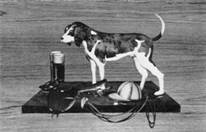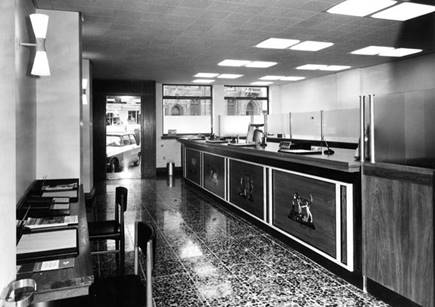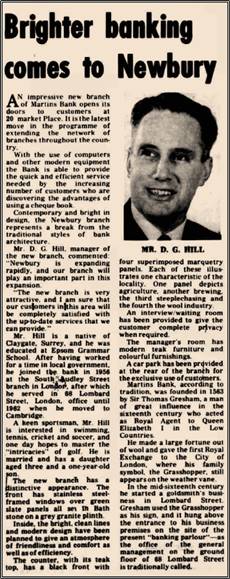|

 Martins Bank’s thirty year long connection with
Berkshire, begins in 1939, in what was always intended to be temporary
premises at READING STATION ROAD.
The Second World War puts paid to plans to move to larger premises,
and it is not until 1960 that a second, purpose built branch arrives in
Reading, at FRIAR STREET. Newbury, on the other hand, is
a brand new branch, and opens in 1966. Until now only Reading has flown the
flag for Martins in Berkshire, and whilst Newbury is the second, it is also
the last, surviving only until the end of 1970. Branches in the home
counties are likely to be the first casualties of Barclays’ reorganisation
following the 1969 merger, because Barclays already has a huge presence in
these areas. Martins Bank’s tradition of adding local “flavour” to the
design and/or décor of a new branch continues at Newbury with a series of
beuatiful wood carvings along the front face of the counter. These depict Weaving. Farming Bewing and
“Chasing” (i.e. hunting with hounds).
These wood panels are amongst several artworks that we are trying to
trace. You can read more about this
in our MOST WANTED feature. In 1966, Martins Bank Magazine visits the
new branch to meet the staff, and to provide its customary take on the
local area… Martins Bank’s thirty year long connection with
Berkshire, begins in 1939, in what was always intended to be temporary
premises at READING STATION ROAD.
The Second World War puts paid to plans to move to larger premises,
and it is not until 1960 that a second, purpose built branch arrives in
Reading, at FRIAR STREET. Newbury, on the other hand, is
a brand new branch, and opens in 1966. Until now only Reading has flown the
flag for Martins in Berkshire, and whilst Newbury is the second, it is also
the last, surviving only until the end of 1970. Branches in the home
counties are likely to be the first casualties of Barclays’ reorganisation
following the 1969 merger, because Barclays already has a huge presence in
these areas. Martins Bank’s tradition of adding local “flavour” to the
design and/or décor of a new branch continues at Newbury with a series of
beuatiful wood carvings along the front face of the counter. These depict Weaving. Farming Bewing and
“Chasing” (i.e. hunting with hounds).
These wood panels are amongst several artworks that we are trying to
trace. You can read more about this
in our MOST WANTED feature. In 1966, Martins Bank Magazine visits the
new branch to meet the staff, and to provide its customary take on the
local area…

Weaving,
Farming, Brewing and Chasing at Newbury…

|
|

|

|

|

|
|

 Berkshire
does not boast, it has no need, and consequently some people only know it
vaguely as being 'over that way'. As for Newbury, unless they follow the
horses, it is 'somewhere beyond Reading', 'the A4 goes by it, I think' and
'weren't there a couple of battles?' Having just
returned we can confirm that Berkshire is indeed 'over that way'; Newbury
lies 17 miles west of Reading and 27 miles south of Oxford, the London to
Bath A4 skirts the top of the town and two Royalist v Roundhead battles
were fought in 1643 and 1644. Newbury
today does very nicely indeed as a country market town and does not seek
fame. Its recent reaction to the planners was so effective that ominous
terms like 'overspill', 'new town' and 'development' were promptly switched
to Swindon 25 miles to the north-west in Wiltshire. One
cannot blame Newbury at all. Already there are 200 factories listed within
the Borough including a marine engineering company whose founder, William
Plenty, invented the first lifeboat. This was tried out on the River
Kennet, which runs through the town, before being exhibited to the Elder
Brethren of Trinity House, and in 1824 eleven of the fourteen lifeboats in
use around the English coast were built in Newbury. The
town is also involved in manufacturing paper and cardboard, diesel engines,
gears and light aircraft. Berkshire
does not boast, it has no need, and consequently some people only know it
vaguely as being 'over that way'. As for Newbury, unless they follow the
horses, it is 'somewhere beyond Reading', 'the A4 goes by it, I think' and
'weren't there a couple of battles?' Having just
returned we can confirm that Berkshire is indeed 'over that way'; Newbury
lies 17 miles west of Reading and 27 miles south of Oxford, the London to
Bath A4 skirts the top of the town and two Royalist v Roundhead battles
were fought in 1643 and 1644. Newbury
today does very nicely indeed as a country market town and does not seek
fame. Its recent reaction to the planners was so effective that ominous
terms like 'overspill', 'new town' and 'development' were promptly switched
to Swindon 25 miles to the north-west in Wiltshire. One
cannot blame Newbury at all. Already there are 200 factories listed within
the Borough including a marine engineering company whose founder, William
Plenty, invented the first lifeboat. This was tried out on the River
Kennet, which runs through the town, before being exhibited to the Elder
Brethren of Trinity House, and in 1824 eleven of the fourteen lifeboats in
use around the English coast were built in Newbury. The
town is also involved in manufacturing paper and cardboard, diesel engines,
gears and light aircraft.
|
|

|
|

|

|
|
Images © Barclays Ref 0033/0400
|
|

Some
of the richest race-horse training establishments are nearby, the
racecourse brings money to the town both over the sticks and on the flat,
and agriculture completes a healthy economic picture. Newbury does not require
a trading estate and those with leisure can fish, hunt or just walk. The
town was world famous in the 15th century for its weaving, and the northern
part, Speenhamland, became famous in the 17th century for its coaching
inns, some of which survive. Weaving declined in the 18th century as the
northern factories gained ascendancy but in 1811 Sir John Throckmorton made
a bold bid to rescue it. He wagered
1,000 guineas that he would sit down to dinner at 8 p.m. wearing a coat
made from wool still on the back of the sheep at 5 a.m. The whole process
of shearing, weaving, dyeing, cutting and making up was accomplished by
6.20 p.m. and the damson-coloured coat is still in existence. Sir John won
his bet, the sheep were roasted and distributed to the people along with
120 gallons of strong ale and although the event failed to revive a dying
trade, the coming of the canal helped the town's revival through its corn
and malt mills and its breweries. That then is the background to a town
which welcomed us with torrential rain, lowering clouds and a mid-April
temperature so low that even the fruit blossom looked furtive: a week
earlier there had been six inches of snow on the racecourse. Partly
protected by an umbrella we snooped around the town finding a remarkable mixture
of buildings ranging from modern down to mediaeval in the half-mile from
north to south. Our new branch is well
sited in Market Square where it cannot be missed and this may explain why
the 'walk-in-and-see' passers-by had swelled the number of customers beyond
the hundred prior to our call. The interior layout reminded us greatly of
Ashford branch with plenty of space though less colourful in that here
white and brown predominate.
 The
car park at the rear will be a big attraction for customers since the busy
main streets are old and, with one exception, narrow. Mr D. G. Hill, is happy
about the prospects and has no regrets for having deserted local government
for banking ten years ago, particularly as he met his wife, Pat Grimsey, at
South Audley Street branch. Mr R. S.
Cooper who came to Newbury after twelve years at Reading will be familiar
to those who have followed the inter-District rugby games in past years. A
former county player, he will be turning out for Newbury next season and
has already made appropriate contacts in the town. Mr J. M. Brown, after eight months'
service at Plymouth branch, was looking forward to his family's arrival in
the area to release him from bed-sitter life, but Miss Anne Russell, a
recent entrant from commerce, had no such problems. Living at Inkpen, south
of Hungerford, she can enjoy the country at its best— gibbet and all! Someone
in the office had mentioned a claim that the sun always shines at Newbury
and certainly it has shone brightly on the new business so far. The solar
lapse in April involved us in the hasty purchase of an editorial umbrella,
but the cost was probably small in relation to the expenses of Dan Quin who
was inspired to write of a local hostelry, the George and Pelican: “The famous inn at Speenhamland, that stands below the
hill, may well be called 'The Pelican',
from its enormous bill”... The
car park at the rear will be a big attraction for customers since the busy
main streets are old and, with one exception, narrow. Mr D. G. Hill, is happy
about the prospects and has no regrets for having deserted local government
for banking ten years ago, particularly as he met his wife, Pat Grimsey, at
South Audley Street branch. Mr R. S.
Cooper who came to Newbury after twelve years at Reading will be familiar
to those who have followed the inter-District rugby games in past years. A
former county player, he will be turning out for Newbury next season and
has already made appropriate contacts in the town. Mr J. M. Brown, after eight months'
service at Plymouth branch, was looking forward to his family's arrival in
the area to release him from bed-sitter life, but Miss Anne Russell, a
recent entrant from commerce, had no such problems. Living at Inkpen, south
of Hungerford, she can enjoy the country at its best— gibbet and all! Someone
in the office had mentioned a claim that the sun always shines at Newbury
and certainly it has shone brightly on the new business so far. The solar
lapse in April involved us in the hasty purchase of an editorial umbrella,
but the cost was probably small in relation to the expenses of Dan Quin who
was inspired to write of a local hostelry, the George and Pelican: “The famous inn at Speenhamland, that stands below the
hill, may well be called 'The Pelican',
from its enormous bill”...

Newbury’s new branch is in the news…
The following quite lavish spread, of which the Directors
of Martins Bank will no doubt have been both pleased and proud is published
in the Reading Evening Post of 2 March 1966. It sets just the right tone
for the still independent Bank’s policy of expansion through the addition
of branches in every major town and city.
|
|

Image © Trinity Mirror
Image created courtesy of
THE BRITISH LIBRARY BOARD.
Image reproduced with
kind permission of
The British Newspaper Archive
www.britishnewspaperarchive.co.uk
|
AN
impressive new branch Martins Bank opens its doors to customers at 20
Market Place. It is the latest move in the programme of extending the
network of branches throughout the country. With the use of computers and
other modern equipment the Bank is able to provide the quick and efficient
service needed by the increasing number of customers who are discovering
the advantages of using a cheque book. Contemporary and bright in design,
the Newbury branch represents a break from the traditional styles of bank
architecture. Mr D G Hill, manager of the new branch, commented “Newbury is
expanding rapidly, and our branch will play an important part in this
expansion. The new branch is very attractive, and I am sure that our
customers in this area will be completely satisfied with the up-to-date
services that we can provide”.

Mr.
Hill is a native of Claygate, Surrey, and he was educated at Epsom Grammar
School After having worked for a time in local government, he joined the
bank in 1956 at the South Audley Street Branch in London, after which he
served in 68 Lombard Street. London, office until 1962 when be moved to
Cambridge. A keen sportsman, Mr Hill
is interested in swimming, tennis, cricket and soccer, and one day hopes to
master the “intricacies” of golf. He
is married and has a daughter aged three and a one-year-old son.

The
new branch has a distinctive appearance. The front hat stainless
steel-framed windows over green slate panels all set in Bath stone on a
grey granite plinth. Inside, the bright, clean lines and modern design have
been planned to give an atmosphere of friendliness and comfort as well as
of efficiency. The counter, with its teak top, has a black front with four
superimposed marquetry panels. Each of them illustrates one characteristic
of the locality. One panel depicts agriculture, another brewing, the third
steeplechasing and the fourth the wool industry. An interview waiting room
has been provided to give the customer complete privacy when required. The
manager’s room has modern teak furniture and colourful furnishings. A car
park has been provided at the rear of the branch for the exclusive use of
customers.

Martins
Bank, according to tradition, was founded in 1563 by Sir Thomas Gresham, a
man of great influence in the sixteenth century who acted as Royal Agent to
Queen Elizabeth I in the Low Countries. He made a large fortune out of wool
and gave the first Royal Exchange to the City of London, where his family
symbol, the Grasshopper, still appears on the weather vane. In the
mid-sixteenth century he started a goldsmith's business in Lombard Street.
Gresham used the Grasshopper as his sign, and it hung above the entrance to
his business premises on the site of the present "banking
parlour" —as the office of the general management on the ground floor
of 68 Lombard Street is traditionally called.
|
|
|
|
|
|

|

